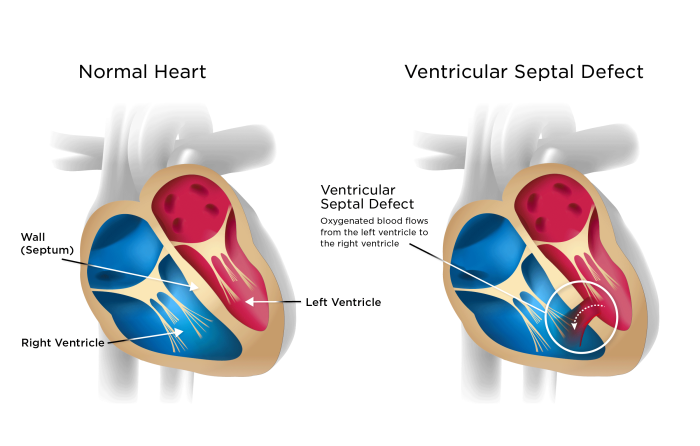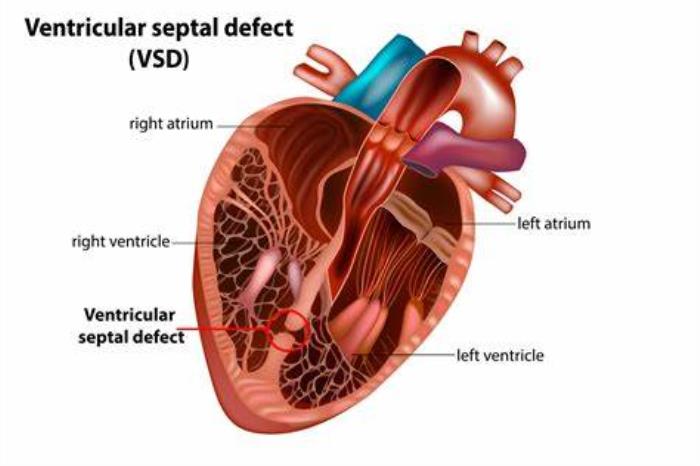Ventricular Septal Defect (VSD) surgery is a critical procedure for individuals with a significant hole between the heart’s ventricles, as untreated VSD can lead to severe complications, such as heart failure, pulmonary hypertension, and irreversible damage to the lungs. VSD surgery aims to close the defect, restore normal blood flow, and prevent further strain on the heart, allowing patients to enjoy improved cardiovascular health and quality of life.
Medical disclaimer: This content is for general awareness and does not replace a doctor’s consultation. For diagnosis or treatment decisions, consult a qualified specialist.
Why VSD Surgery is Recommended: Addressing Health Risks
Surgery is typically recommended for individuals with moderate to large VSDs that cause symptoms or place excessive strain on the heart and lungs. Without surgical intervention, VSDs can increase the risk of heart failure and long-term complications like Eisenmenger syndrome, where high blood pressure in the lungs becomes irreversible. Timely VSD repair helps prevent these serious health risks, supporting better overall heart function.
Overview of the Surgical Process for VSD Repair
VSD surgery usually involves an open-heart procedure, where the surgeon accesses the heart through the chest to close the hole in the ventricular septum. During the operation, a heart-lung machine temporarily takes over the function of the heart and lungs, allowing the surgeon to work on a still heart. The defect is closed using a patch or stitches, depending on the size and location of the hole. In recent years, less invasive options, such as catheter-based procedures, have become available for certain patients with smaller defects.

Common Risks Associated with VSD Surgery
While VSD surgery is generally safe, like all surgeries, it carries certain risks. Common risks include reactions to anesthesia, bleeding, and infection. Additionally, the heart’s electrical system could be affected during surgery, potentially resulting in arrhythmias, or abnormal heart rhythms. Surgeons take many precautions to minimize these risks, and the benefits of repairing the defect often outweigh these potential complications.
Potential Complications During VSD Surgery
During VSD surgery, complications such as arrhythmias, air embolism, and damage to surrounding tissues may occur, though these risks are rare with modern surgical techniques. In some cases, the electrical pathways within the heart may be affected, requiring the use of a pacemaker. To reduce these risks, surgeons carefully monitor and manage the patient’s heart function throughout the procedure.
Post-Surgery Infection Risks and Prevention
Infections at the surgical site or within the chest cavity are potential post-surgery complications. These infections can delay recovery and, in severe cases, lead to further issues such as endocarditis, an infection of the heart lining. Preventive measures include stringent surgical sterilization, post-operative wound care, and, if necessary, antibiotic treatments to address early signs of infection.
Risks of Bleeding and Blood Clots After VSD Surgery
After VSD surgery, there is a risk of bleeding, especially within the first few days post-operation. Blood clots can also form at the surgical site or in blood vessels, potentially leading to complications such as deep vein thrombosis (DVT) or even stroke. Patients are closely monitored for signs of bleeding or clotting, and anticoagulants may be prescribed to help prevent blood clot formation as part of the post-operative care.
Heart Rhythm Irregularities: A Possible Complication
Heart rhythm irregularities, such as arrhythmias, can occur after VSD surgery due to changes in the heart's structure and electrical pathways. While some arrhythmias are temporary, others may require treatment to manage heart rate and rhythm. Continuous monitoring is essential to detect any abnormalities early and adjust treatment if needed.
Lung Complications Following VSD Surgery
Following VSD surgery, some patients may experience lung-related complications, including pneumonia, pleural effusion (fluid buildup around the lungs), or respiratory distress. These complications are more common in patients with larger defects or those who have had prolonged heart strain. Prompt treatment, including respiratory support, can help prevent long-term lung issues.
Anesthesia-Related Risks: What to Know Before Surgery
Anesthesia carries risks, particularly in patients with heart defects like VSD. It can affect heart function, respiratory control, and blood pressure during surgery. Preoperative assessments, including discussions about anesthesia plans, help mitigate these risks. Your medical team will tailor the anesthesia approach based on your overall health and the nature of the VSD surgery.
Delayed Healing and Wound Care After VSD Surgery
Proper wound care is crucial to prevent infections and promote healing after VSD surgery. Delayed healing can occur, particularly in older patients or those with underlying conditions such as diabetes. Following your surgeon's instructions on wound care and attending follow-up appointments is vital for reducing the risk of complications like infection or improper healing.
Risk of Residual Defect: Incomplete Closure of the Septum
In some cases, a residual defect may remain after VSD surgery, where the ventricular septum has not fully closed. This can lead to persistent symptoms like shortness of breath, fatigue, or arrhythmias. Regular follow-up echocardiograms can help detect any residual defects, ensuring that further intervention is made if needed.
Long-Term Complications of VSD Surgery
While VSD surgery is often successful, long-term complications can include heart valve issues, arrhythmias, and pulmonary hypertension. These issues may develop years after surgery, especially if there was significant damage to the heart prior to surgery. Monitoring and ongoing heart care are necessary to address any evolving concerns.
Managing Scar Tissue Formation Post-Surgery
Scar tissue can form after VSD surgery, particularly if the repair was done through open-heart surgery. This tissue may interfere with heart function, potentially leading to arrhythmias or restricted blood flow. Regular imaging and checkups can help identify and manage scar tissue complications before they become problematic.
Potential for Right or Left Heart Failure After VSD Surgery
Heart failure may occur if the heart's ability to pump blood is compromised during or after surgery. Right heart failure can result from excessive blood flow to the lungs, while left heart failure may arise if the heart’s pumping efficiency is reduced. Close monitoring after surgery helps identify signs of heart failure early, improving long-term recovery.

Neurological Complications: Stroke and Brain Injury Risks
Although rare, neurological complications like stroke or brain injury can occur after VSD surgery, especially if there is a blood clot or if the heart struggles to pump blood effectively during surgery. Preventive measures, including anticoagulation therapy and close monitoring, are used to reduce these risks. Early recognition of symptoms such as confusion or weakness can help minimize damage.
Steps to Minimize Risks and Promote a Safe Recovery
To minimize risks, it is essential to follow all post-surgery care instructions, attend follow-up appointments, and make lifestyle modifications that support heart health. These may include managing blood pressure, staying active, avoiding smoking, and adhering to prescribed medications to prevent complications and enhance healing.
How to Identify Post-Operative Complications Early
Recognizing the signs of complications early can help prevent serious issues. Watch for symptoms such as increasing pain, fever, shortness of breath, chest pain, swelling in the legs, or dizziness. If any of these symptoms occur, contact your healthcare provider immediately to address potential complications.
Follow-Up Care: Monitoring Health After VSD Surgery
Follow-up care is critical to ensure a successful recovery after VSD surgery. Regular checkups, echocardiograms, and other tests will monitor heart function and detect any signs of complications, such as arrhythmias or residual defects. Following your doctor’s schedule for appointments helps catch any issues early, ensuring better long-term outcomes.
Conclusion: Balancing Benefits and Risks in VSD Surgery
VSD surgery is a highly effective treatment for managing ventricular septal defects, but like all surgeries, it carries risks. Understanding these risks, following post-operative instructions, and maintaining regular follow-up care are essential for a smooth recovery and minimizing complications. With the right approach, the benefits of VSD surgery far outweigh the risks, leading to improved heart function and quality of life.
Best VSD Surgery in India
The Best VSD Surgery in India offers effective treatment for ventricular septal defects, helping improve heart function and quality of life for patients with congenital heart defects.
Best VSD Surgery Hospitals in India
The best vsd surgery hospitals in india are equipped with advanced cardiac care facilities and specialized pediatric teams, providing comprehensive care from diagnosis through recovery.
VSD Surgery Cost in India
The vsd surgery cost in india is affordable and transparent, offering high-quality care and accessible options for patients at leading hospitals.
Best VSD Surgeons in India
The Best VSD Surgeons in India are experts in congenital heart defect repairs, providing precise and compassionate care tailored to each patient’s unique needs.
FAQ
What are the risks involved in VSD surgery?
The risks include heart rhythm irregularities, lung complications, infection, residual defects, and possible neurological complications such as stroke. These risks can be managed with proper care and monitoring.
Can complications arise years after VSD surgery?
Yes, complications like heart valve problems, arrhythmias, and pulmonary hypertension can develop long after surgery, so regular follow-up care is essential.
How can I reduce the risk of infection after VSD surgery?
To reduce infection risk, follow proper wound care instructions, keep the surgical site clean, and attend all follow-up appointments. Your doctor may also prescribe antibiotics as a preventive measure.
Is it common to experience heart rhythm issues after VSD repair?
Heart rhythm issues can occur, particularly if the heart’s electrical pathways were affected during surgery. Regular monitoring helps detect and manage these issues early.
What follow-up care is needed after VSD surgery?
Follow-up care includes routine checkups, echocardiograms to monitor heart function, and possible lifestyle adjustments to support recovery and prevent complications. Regular visits with your healthcare team are key to long-term success.